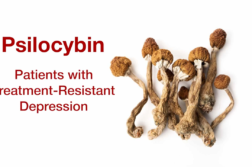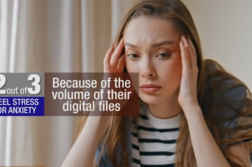CINCINNATI, Ohio. (Ivanhoe Newswire)—May is Mental Health Awareness Month. As many as 30 percent of Americans who have major depression may try medication after medication, and not find anything that works. Scientists are now studying a new method that could help relieve symptoms, spinal stimulator.
Seven percent of all American adults have at least one episode of major depression each year— depression that lasts two weeks or longer. Treatments include counseling, medications, or transcranial magnetic stimulation, TMS, to stimulate the mood-regulating parts of the brain.
Francisco Romo-Nava MD, PhD, a physician scientist and assistant professor in the department of psychiatry and behavioral neuroscience at the University of Cincinnati College of Medicine and associate chief research officer at the Lindner Center of HOPE, explained “Not all patients respond to the medication or to the neuromodulation.”
Dr. Romo-Nava and colleagues are studying a new way to treat mental health disorders. The neuroscientists are testing a device that delivers stimulation to a patient’s spine. Dr. Romo-Nava says the stimulation will improve the feedback in the central nervous system that is sometimes disrupted when a person has a psychiatric disorder. For now, patients undergo spinal stimulation for 20 minutes, three times a week, for eight weeks.
“The kind of stimulation that we use is very well tolerated. The most frequent description is like a tingling sensation,” shared Dr. Romo-Nava.
Researchers say this stimulation therapy could be the first step to developing better treatment for some patients.
Dr. Romo-Nava was recently granted a U.S. patent for the stimulation method that utilizes transcutaneous spinal cord stimulation for the treatment of psychiatric disorders. He says his research team is trying to determine how often, and how long, patients should undergo the stimulation for the best results.
Contributors to this news report include: Cyndy McGrath, Executive & Field Producer; Kirk Manson, Videographer; Roque Correa, Editor.
To receive a free weekly e-mail on Medical Breakthroughs from Ivanhoe, sign up at: http://www.ivanhoe.com/ftk
Sources:
https://www.jnj.com/health-and-wellness/4-facts-about-treatment-resistant-depression
https://www.healthline.com/health/depression/facts-statistics-infographic
MEDICAL BREAKTHROUGHS
RESEARCH SUMMARY
TOPIC: SPINAL STIMULATOR TREATS DEPRESSION
REPORT: MB #4899
BACKGROUND: Depression is a common, but treatable, medical illness that negatively affects how you feel, the way you think, and how you act. It can cause feelings of sadness and/or a loss of interest in activities, and lead to a variety of emotional and physical problems which can decrease your ability to function at work and at home. Depression affects an estimated one in 15 adults in any given year, and one in six people will experience depression at some time in their life. Symptoms must last at least two weeks and represent a change in previous levels of functioning for a diagnosis. Medical conditions such as thyroid problems, a brain tumor, or vitamin deficiency can mimic symptoms of depression, so it is important to rule out general medical causes.
(Source: https://www.psychiatry.org/patients-families/depression/what-is-depression)
COMMON TREATMENTS FOR DEPRESSION: Between 80 and 90 percent of people with depression respond well to treatment, and almost all patients gain some relief from their symptoms. Brain chemistry may contribute to an individual’s depression and factor into their treatment. In this case, antidepressants may be prescribed to help modify one’s brain chemistry. Psychiatrists usually recommend that patients continue taking medication for six or more months after the symptoms have improved. Psychotherapy, or “talk therapy,” is sometimes used alone for treatment of mild depression. For moderate to severe depression, psychotherapy is often used along with antidepressant medications. Cognitive behavioral therapy has been found to be effective in treating depression. This is a form of therapy focused on the problem solving in the present. Electroconvulsive Therapy (ECT) is a medical treatment that has been mostly reserved for patients with severe major depression who have not responded to other treatments. It involves a brief electrical stimulation of the brain while the patient is under anesthesia. A patient may receive ECT two to three times a week for a total of six to 12 treatments and is usually managed by a team of trained medical professionals.
(Source: https://www.psychiatry.org/patients-families/depression/what-is-depression)
NEW TREATMENT BEING STUDIED: A new form of magnetic brain stimulation relieved symptoms of severe depression in 90 percent of participants in a study conducted by researchers at the Stanford University School of Medicine. The researchers are conducting a larger, double-blinded trial in which half the participants are receiving fake treatment and are optimistic it will prove to be similarly effective in treating people whose condition hasn’t improved with medication, talk therapy, or other forms of electromagnetic stimulation. The treatment is called Stanford Accelerated Intelligent Neuromodulation Therapy, or SAINT, and is a form of transcranial magnetic stimulation. They reported the therapy improves on current FDA-approved protocols by increasing the number of magnetic pulses, speeding up the pace of the treatment and targeting the pulses according to each individual’s neurocircuitry.
FOR MORE INFORMATION ON THIS REPORT, PLEASE CONTACT:
KATIE PENCE
513-504-1514
If this story or any other Ivanhoe story has impacted your life or prompted you or someone you know to seek or change treatments, please let us know by contacting Marjorie Bekaert Thomas at mthomas@ivanhoe.com




